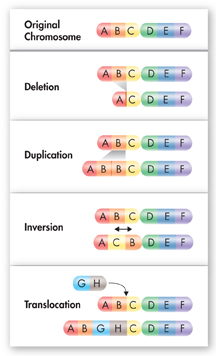
FIGURE 13–12 Chromosomal Mutations Four types of mutations cause changes in whole chromosomes. Use Diagrams What is the difference between inversion and translocation?
Chromosomal Mutations Chromosomal mutations involve changes in the number or structure of chromosomes. These mutations can change the location of genes on chromosomes and can even change the number of copies of some genes.
Figure 13–12 shows four types of chromosomal mutations: deletion, duplication, inversion, and translocation. Deletion involves the loss of all or part of a chromosome; duplication produces an extra copy of all or part of a chromosome; and inversion reverses the direction of parts of a chromosome. Translocation occurs when part of one chromosome breaks off and attaches to another.
Effects of Mutations
 How do mutations affect genes?
How do mutations affect genes?
Genetic material can be altered by natural events or by artificial means. The resulting mutations may or may not affect an organism. And some mutations that affect individual organisms can also affect a species or even an entire ecosystem.
Many mutations are produced by errors in genetic processes. For example, some point mutations are caused by errors during DNA replication. The cellular machinery that replicates DNA inserts an incorrect base roughly once in every 10 million bases. But small changes in genes can gradually accumulate over time.
Quick Lab
GUIDED INQUIRY
Modeling Mutations
Small mutations in DNA can cause huge changes in the proteins that are synthesized. Similarly, small changes in a word can dramatically alter its meaning. Look at the following sequence of words:

Notice that each word differs from the previous word by just one letter and that none of the words is meaningless. Think of these changes as “point mutations” that affect word meaning.
Apply Concepts Start with the word gene, and change it letter by letter to make new words. Make sure each new word is an actual word but not a proper noun. Write at least four “point mutations” of the word gene.
Apply Concepts Show how you could use words to model a frameshift mutation. (Hint: You can use a sentence.)
Use Models Use the words in this sentence to model a substitution mutation.
Analyze and Conclude
Table of Contents
- Formulas and Equations
- Applying Formulas and Equations
- Mean, Median, and Mode
- Estimation
- Using Measurements in Calculations
- Effects of Measurement Errors
- Accuracy
- Precision
- Comparing Accuracy and Precision
- Significant Figures
- Calculating With Significant Figures
- Scientific Notation
- Calculating With Scientific Notation
- Dimensional Analysis
- Applying Dimensional Analysis




